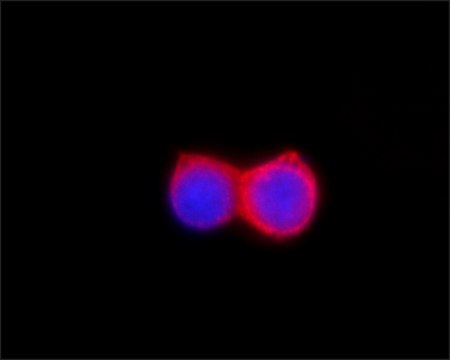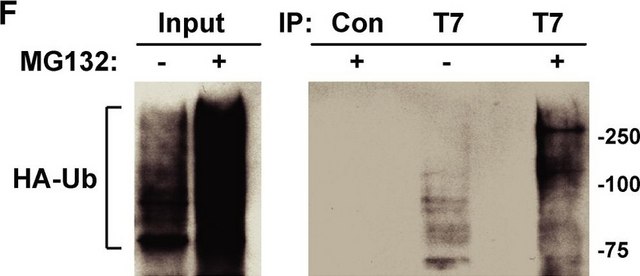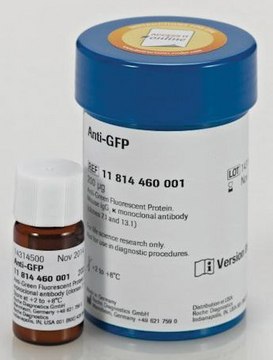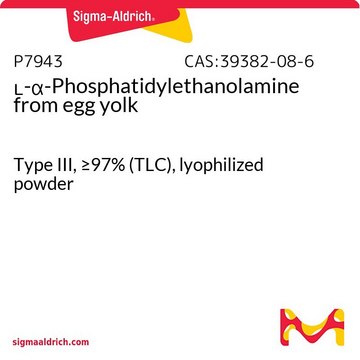05-891
Anti-phospho-ATF2 (Thr69/71) Antibody, clone AW65
clone AW65, Upstate®, from mouse
Sign Into View Organizational & Contract Pricing
All Photos(1)
About This Item
UNSPSC Code:
12352203
eCl@ss:
32160702
NACRES:
NA.41
Recommended Products
biological source
mouse
antibody form
purified antibody
antibody product type
primary antibodies
clone
AW65, monoclonal
species reactivity
mouse, human
manufacturer/tradename
Upstate®
technique(s)
immunoprecipitation (IP): suitable
western blot: suitable
isotype
IgG1
NCBI accession no.
UniProt accession no.
shipped in
wet ice
target post-translational modification
phosphorylation (pThr69/pThr71)
Gene Information
human ... ATF2(1386)
Specificity
ATF2 phosphorylated at both Thr69 and Thr71
Predicted to cross-react with rat based on sequence homology
Immunogen
KLH-conjugated, synthetic peptide containing the sequence ...DQ[pT]P[pT]P... in which [pT] corresponds to phospho-threonine at residues 69 and 71 of human ATF2
Application
Anti-phospho-ATF2 (Thr69/71) Antibody, clone AW65 is a high quality Mouse Monoclonal Antibody for the detection of phospho-ATF2 (Thr69/71) & has been validated in IP & WB.
Research Category
Epigenetics & Nuclear Function
Epigenetics & Nuclear Function
Research Sub Category
Transcription Factors
Transcription Factors
Quality
routinely evaluated by immunoblot with RIPA lysates from anisomycin treated 3T3/NIH cells
Target description
Mr 65kDa
Linkage
Replaces: 04-199
Physical form
Format: Purified
Protein G Purified
Storage and Stability
stable 2 years at -20°C from date of shipment
Legal Information
UPSTATE is a registered trademark of Merck KGaA, Darmstadt, Germany
Disclaimer
Unless otherwise stated in our catalog or other company documentation accompanying the product(s), our products are intended for research use only and are not to be used for any other purpose, which includes but is not limited to, unauthorized commercial uses, in vitro diagnostic uses, ex vivo or in vivo therapeutic uses or any type of consumption or application to humans or animals.
Not finding the right product?
Try our Product Selector Tool.
Storage Class Code
10 - Combustible liquids
WGK
WGK 1
Certificates of Analysis (COA)
Search for Certificates of Analysis (COA) by entering the products Lot/Batch Number. Lot and Batch Numbers can be found on a product’s label following the words ‘Lot’ or ‘Batch’.
Already Own This Product?
Find documentation for the products that you have recently purchased in the Document Library.
Shuhui Zheng et al.
Cardiovascular pharmacology: open access, 4(1) (2015-04-01)
The cell type that normally limits the inflammatory and atherosclerotic process is the vascular endothelial cell (EC) that can be regulated by proinflammatory and various stresses. Toll-like receptor-4 (TLR4) plays an important role in the pathogenesis of atherosclerosis, in part
Mumtaz Y Balkhi et al.
iScience, 2, 105-122 (2018-11-15)
T cells infiltrate affected organs in chronic infections and malignancy, but they may fail to eradicate virus-infected cells or tumor because of exhaustion. This report describes a Yin Yang-1 (YY1)-centered mechanism for diverse components that have been correlated with exhaustion.
Ahmad Salameh et al.
The Journal of biological chemistry, 285(30), 23096-23104 (2010-05-29)
Growth factor stimulation induces c-Jun-dependent survival of primary endothelial cells. However, the mechanism of c-Jun anti-apoptotic activity has not been identified. We here demonstrate that in response to growth factor treatment, primary human endothelial cells as well as mouse fibroblasts
Klára Kirsch et al.
Nature communications, 11(1), 5769-5769 (2020-11-15)
Transcription factor phosphorylation at specific sites often activates gene expression, but how environmental cues quantitatively control transcription is not well-understood. Activating protein 1 transcription factors are phosphorylated by mitogen-activated protein kinases (MAPK) in their transactivation domains (TAD) at so-called phosphoswitches
Mireille Delhase et al.
Proceedings of the National Academy of Sciences of the United States of America, 109(4), E177-E186 (2011-12-29)
The decision between survival and death in cells exposed to TNF relies on a highly regulated equilibrium between proapoptotic and antiapoptotic factors. The TNF-activated antiapoptotic response depends on several transcription factors, including NF-κB and its RelA/p65 subunit, that are activated
Our team of scientists has experience in all areas of research including Life Science, Material Science, Chemical Synthesis, Chromatography, Analytical and many others.
Contact Technical Service








